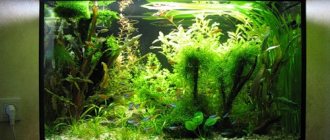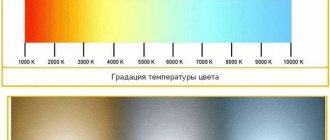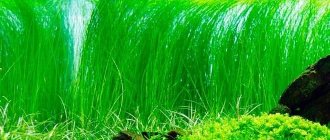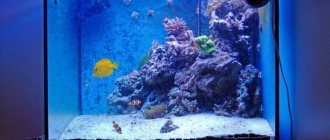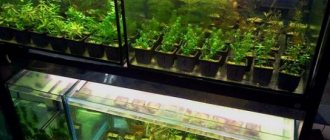Electrician in the house
Encyclopedia about electricity from A to Z
Masters catalog
Find the best master or company in your city
A real underwater garden in your home
In the recent Soviet past, people, due to the lack of diversity on television and the absence of the Internet, led full lives, reading a lot and devoting themselves to some hobbies. Aquariums were one of the most beloved and beautiful activities; the country had millions of amateurs and professionals.
Today, quantity has turned into quality, and a simple glass parallelepiped has acquired completely new, beautiful and unusual shapes. A large role in the correct organization of underwater life is played by the lighting of the aquarium for plants and fish, plus, lighting can make it a real work of art. We'll talk about this in today's article.
- Light in the aquarium Result of improper lighting
- Common Mistakes
- Main characteristics
Types of lamps
Lamps are divided into types, differing in energy consumption and power.
- Incandescent. The only pet for which this aquarium lighting is suitable is the land turtle. An incandescent lamp overheats the water and produces heat, which does not prevent the growth of algae and pathogenic bacteria. Good quality lamps are energy consuming.
- Luminescent. This is not the best way to properly illuminate an aquarium, but it is quite suitable for unpretentious creatures. Has low power.
- Metal halide. These lamps are a good option for aquariums. They are energy-efficient, small in size, have a long service life, and have high luminous efficiency. Metal halide lamps are similar to natural solar radiation, which has a good effect on the well-being of the inhabitants.
- LED. Suitable for most pets. They are comfortable in terms of aquarium light, durability, and have a wide spectrum of luminescence. The downside of these lamps is the high cost of quality products. It is produced not only in the form of lamps, but also as LED panels and spotlights.
More details about the types of lamps, aquarium lamps, and their characteristics are described separately.
Getting to know the light parameters that will be useful when choosing a lamp
The choice of aquarium lighting is also based on the following parameters:
- Spectrum of light. In simple words, this is the wavelength. Its size can reach from 380 to 780 mln. Visually, a person perceives the size of the wave as a certain shade. For example, violet is short wavelength, red is long wavelength. A striking example is the rainbow.
- Lux is a unit of illumination that is responsible for the intensity of the luminous flux. It is equal to Lumen.
- Lumen is the amount of light a source emits. One unit of lumen is the luminous flux capable of illuminating one square meter of area.
- Ra. This is an indicator characterizing the color rendition of lighting. Thanks to this parameter, it is easy to determine whether the rays of light will be perceived naturally. The indicator can vary from 0 to 100 units.
The listed parameters are certainly important, since they directly affect the life activity of living creatures in the aquarium.
Lilac aquarium lamps Source aqua-led.ru
Characteristics of aquarium lighting
Basic power standards for lighting devices:
- 0.1-0.3 Watt per liter of aquarium. It is preferred to keep inhabitants with a nocturnal lifestyle, catfish. Of the plants, low power is suitable for Java moss, Vallisneria.
- 0.4-0.5 Watt/l. Plants will grow slowly in such a tank. Shade-loving plants should be planted, because other species will stretch towards the light source and become thin and weak.
- 0.5-0.8 Watt/l. This is the best option for a standard aquarium. The plants grow well and do not lack aquarium light.
- 0.8-1 Watt/l. This power is suitable for fish and plants living in constant direct sunlight. This indicator is also necessary for aquascaping and aquarium keeping with a larger number of plants.
Advantages and disadvantages
Before choosing a round aquarium for your room’s interior, it is recommended to get acquainted with its pros and cons.
Advantages:
- Round shaped tanks are cheaper in price than a similar rectangular one of the same size.
- The design of spherical home ponds is presented in a large assortment.
- Thanks to their rounded shapes, they are compact and take up less space.
- Easier to move from place to place thanks to the comfortable grip.
- The round shape is easier to clean from fish waste products.
- In the interior of a room or office they look stylish and elegant.
- In a non-standard model of a home pond, you can create an original water landscape.
Flaws:
- Round shaped aquariums are very cramped for many fish species.
- It is impossible to install a full-fledged filter system. This limits the number of fish species allowed to be kept.
- The flask narrows upward, air exchange is worse, you will have to change the water more often.
- It is absolutely impossible to keep marine fish species in them, because it is almost impossible to maintain the required levels of salt water.
- The spherical shape of the walls distorts perception, which negatively affects the fish.
- Plants are much more difficult to place.
However, these shortcomings do not frighten aquarists. They manage to successfully keep aquarium fish in round shapes for many years.
Lighting selection
- When choosing equipment, select the intensity and saturation of light. To do this, the characteristics of the tank are taken into account: the number of fish, plants, tank volume, water salinity, amount of water.
- Selecting the lamp type. The impact on fish and cost depend on this choice.
- Choose underwater creatures and greenery with approximately the same light requirements. But you should focus on vegetation, it is this that releases oxygen into the water.
Underwater lighting
If there is a lack of light or additional lighting of parts of the tank, underwater lighting for the aquarium is used - a spotlight. An aquarium light consists of a hermetically sealed container and a bright light source inside. It comes in white, blue, red. Most often used for decoration, intentional lighting of underwater figures or other decor.
How to register it?
Designing a round aquarium requires a special approach. An aquarium is not only an interior object. Its main function is to create conditions for the life of aquatic creatures. Therefore, you will have to purchase special equipment for a round aquarium.
Without it, the fish will not be able to survive. It is necessary to place a compressor, a heater, a filter in the flask, and provide lighting. Conventional devices will not work; they will stand out too much in the water space. When purchasing, you should choose models that indicate “for a round aquarium.”
The shape and dimensions allow them to be carefully placed so as to least spoil the appearance. Pebbles are placed scattered at the bottom, and plants take root in them. Equipment for a round aquarium is hidden as much as possible by plant shoots.
It is advisable to select aquatic plants such that they do not hide the main inhabitants with their bizarre appearance. And pay special attention to the shape and size of the pebbles. Remember, in a round aquarium all the details look more prominent. Therefore, any defect is immediately noticeable.
Where to place the lighting for the aquarium
Illumination and spotlights are located at the top next to other lamps or on the side walls. Less often, lighting is built into the ground or among greenery.
Number of lamps and their placement
For a small volume tank, one lamp with low power will be enough. But in large tanks you will have to equip two or three high-power lamps.
Lamps are usually placed on top, on the lid. It is also possible to place lighting in the aquarium on the sides of the walls.
Equipment
Required equipment includes:
- filter;
- compressor;
- heater;
- backlight;
- stand.
If you are still interested in a round aquarium, you should be attentive to its shortcomings, but not afraid of them. First, decide on the volume. As mentioned above, the average volume of round aquariums is 10 liters, but you can purchase containers of 20 or 30 liters.
You will need special equipment to create cozy conditions. These are a compressor, a bottom filter and a heater. It is also necessary to provide a glass aquarium with lighting, although it will be difficult to install it yourself. In order not to complicate your life, it is better to purchase a container with a built-in lamp.
As for the rest, the heater, filter and compressor are purchased separately. At the pet store you can find special models for round containers - for example, a round bottom filter or a convenient compressor that can be hidden in tight spaces. There are aquariums with a built-in filter.
In addition to the equipment, you will need a lid for a round aquarium. She has several tasks at once:
- prevents fish from jumping out of the container;
- serves as protection from curious cats who may want to eat the fish;
- A lighting fixture is attached to the cover.
Finding the cover separately can be difficult. This is the second reason why it is better to choose a round aquarium with a lid. The aquarium stand is included in the kit, but it can be made to order or purchased separately in the store.
Light intensity
The intensity in the tank should be selected taking into account the specifics of the tank: what is the salinity of the water, how consuming are the plants, color, depth of the water. For these conditions, lamps with optimal lighting are selected.
Selection by volume
Having built the lighting based on the volume, you can change it to suit other conditions. It is important to take not the volume of the container itself, but the volume of water, without air, soil.
One liter in a standard tank requires 0.5-0.8 watts. This value varies depending on the needs of fish and vegetation.
Selection by depth
Selecting the depth of the aquarium lighting is problematic, because light is absorbed every 10 cm of water - 50% of the photons are scattered and do not reach the next layer. If there is good lighting at the top, only a small amount of light will reach the bottom. Therefore, the deeper the aquarium, the more powerful its lighting should be.
What kind of fish can be kept in a small round aquarium?
fish for a small aquarium
In this section we will simply list candidates that can be contained in small quantities.
The first and most popular fish are bettas and other bettas. These fish are unpretentious in keeping, breathe atmospheric air, and are slow. In their natural habitat, they live in swamps, puddles, and rice fields in Asia. This is actually why they do not require large volumes. In addition, keeping bettas in a school is virtually impossible - they are solitary fish. It’s not for nothing that they are called fighting bettas, these fish have pronounced intraspecific aggression, males fight and kill each other in duels, even females can be killed by Othello males just like that, one might say because of a bad mood. Even during the period of seemingly mating games... after spawning, the female is immediately separated from the male, otherwise the despot will mercilessly beat his beloved.
Taking these features into account, males are the first candidates for single-chamber housing in small volumes.
The second candidates are guppies and Endler's guppies. Also small, slow veiled fish. Their only drawback in relation to a small aquarium volume is their fertility. These viviparous fish give birth like rabbits. In this connection, taking into account our volumes, it is better to keep 2-3 males, without females.
The third platoon is all small tetras and rasboras. The only thing we note is that these are quite fast and nimble fish. In this regard, they are not very suitable for small ponds.
The fourth recommendation is cichlids! Yes, why not, there are wonderful representatives of dwarf cichlids - apistograms !
You can continue the list of fish that can be kept in a small round aquarium: zebrafish , Iriaterina Werner , aphiosemion , gambusia , cardinals , limia , microrabora , nothobranchius , pseudomugili , etc. But there are other hydrobionts that will live well in our small aquarium - snails and shrimp .
It is only important to always remember that we are responsible for those we have tamed!




